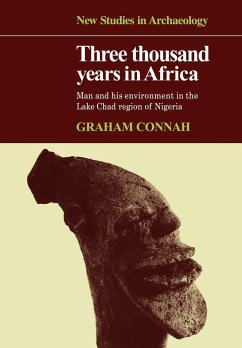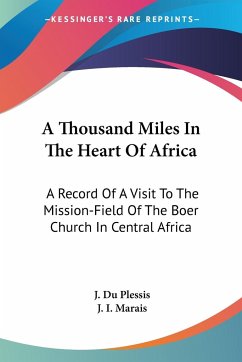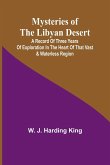Graham Connah
Three Thousand Years in Africa
Man and His Environment in the Lake Chad Region of Nigeria
Graham Connah
Three Thousand Years in Africa
Man and His Environment in the Lake Chad Region of Nigeria
- Broschiertes Buch
- Merkliste
- Auf die Merkliste
- Bewerten Bewerten
- Teilen
- Produkt teilen
- Produkterinnerung
- Produkterinnerung
Presents a natural history of Man in the Lake Chad region of Nigeria.
Andere Kunden interessierten sich auch für
![A Thousand Miles In The Heart Of Africa A Thousand Miles In The Heart Of Africa]() J. Du PlessisA Thousand Miles In The Heart Of Africa24,99 €
J. Du PlessisA Thousand Miles In The Heart Of Africa24,99 €![A thousand miles up the Nile A thousand miles up the Nile]() Amelia B. EdwardsA thousand miles up the Nile31,99 €
Amelia B. EdwardsA thousand miles up the Nile31,99 €![John Dunn, Cetywayo and the Three Generals John Dunn, Cetywayo and the Three Generals]() John DunnJohn Dunn, Cetywayo and the Three Generals27,99 €
John DunnJohn Dunn, Cetywayo and the Three Generals27,99 €![Mysteries of the Libyan Desert; A record of three years of exploration in the heart of that vast & waterless region Mysteries of the Libyan Desert; A record of three years of exploration in the heart of that vast & waterless region]() W. J. Harding KingMysteries of the Libyan Desert; A record of three years of exploration in the heart of that vast & waterless region23,99 €
W. J. Harding KingMysteries of the Libyan Desert; A record of three years of exploration in the heart of that vast & waterless region23,99 €![Running a Thousand Miles for Freedom Running a Thousand Miles for Freedom]() William CraftRunning a Thousand Miles for Freedom29,99 €
William CraftRunning a Thousand Miles for Freedom29,99 €![The Thousand and One Nights in Arabic Literature and Society The Thousand and One Nights in Arabic Literature and Society]() Richard HovannisianThe Thousand and One Nights in Arabic Literature and Society77,99 €
Richard HovannisianThe Thousand and One Nights in Arabic Literature and Society77,99 €![The Benedictines In Bath During A Thousand Years The Benedictines In Bath During A Thousand Years]() John Clement FowlerThe Benedictines In Bath During A Thousand Years21,99 €
John Clement FowlerThe Benedictines In Bath During A Thousand Years21,99 €-
-
-
Produktdetails
- Produktdetails
- Verlag: Cambridge University Press
- Seitenzahl: 292
- Erscheinungstermin: 27. Januar 2009
- Englisch
- Abmessung: 244mm x 170mm x 16mm
- Gewicht: 508g
- ISBN-13: 9780521109376
- ISBN-10: 052110937X
- Artikelnr.: 26032690
- Herstellerkennzeichnung
- Libri GmbH
- Europaallee 1
- 36244 Bad Hersfeld
- gpsr@libri.de
- Verlag: Cambridge University Press
- Seitenzahl: 292
- Erscheinungstermin: 27. Januar 2009
- Englisch
- Abmessung: 244mm x 170mm x 16mm
- Gewicht: 508g
- ISBN-13: 9780521109376
- ISBN-10: 052110937X
- Artikelnr.: 26032690
- Herstellerkennzeichnung
- Libri GmbH
- Europaallee 1
- 36244 Bad Hersfeld
- gpsr@libri.de
The author was born in Cheshire, educated at the Wirral Grammar School, served on a destroyer in the Mediterranean, read history and archaeology at Cambridge University, and worked there as a research assistant. After experience on numerous excavations in Britain, including as assistant director and director, in 1961 he went to Nigeria, where he spent ten years excavating and on fieldwork. In 1971, he moved to the University of New England in Australia, founding the archaeology department there and later becoming its foundation professor. He returned to Nigerian fieldwork in 1978 and 1981 and subsequently excavated in Egyptian Nubia and Uganda. He also contributed to Australian historical archaeology and founded the journal Australasian Historical Archaeology. He is a Fellow of the Royal Anthropological Institute, a Fellow of the Society of Antiquaries, a Fellow of the Australian Academy of Humanities, MA (Cantab), D.Litt (UNE), and holds the Order of Australia.
Preface and acknowledgements
1. Ways of looking at the past
2. The African savanna and Lake Chad
3. Environment and Man in north-west Nigeria
4. The archaeological landscape and its interpretation
5. The earliest evidence
6. The firki response: Daima I
7. The firki response: Daima II
8. The firki response: Daima III
9. Sand adaptations and the Yobe advantage
10. Urbanisation and state development
11. Towards an understanding
Bibliography
Index.
1. Ways of looking at the past
2. The African savanna and Lake Chad
3. Environment and Man in north-west Nigeria
4. The archaeological landscape and its interpretation
5. The earliest evidence
6. The firki response: Daima I
7. The firki response: Daima II
8. The firki response: Daima III
9. Sand adaptations and the Yobe advantage
10. Urbanisation and state development
11. Towards an understanding
Bibliography
Index.
Preface and acknowledgements
1. Ways of looking at the past
2. The African savanna and Lake Chad
3. Environment and Man in north-west Nigeria
4. The archaeological landscape and its interpretation
5. The earliest evidence
6. The firki response: Daima I
7. The firki response: Daima II
8. The firki response: Daima III
9. Sand adaptations and the Yobe advantage
10. Urbanisation and state development
11. Towards an understanding
Bibliography
Index.
1. Ways of looking at the past
2. The African savanna and Lake Chad
3. Environment and Man in north-west Nigeria
4. The archaeological landscape and its interpretation
5. The earliest evidence
6. The firki response: Daima I
7. The firki response: Daima II
8. The firki response: Daima III
9. Sand adaptations and the Yobe advantage
10. Urbanisation and state development
11. Towards an understanding
Bibliography
Index.









